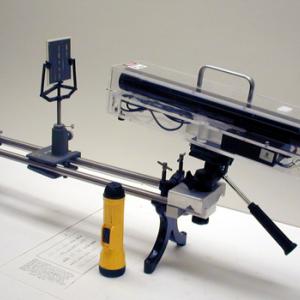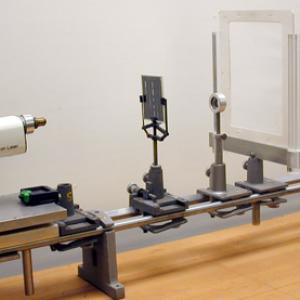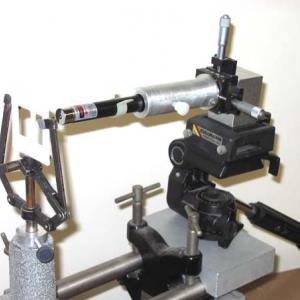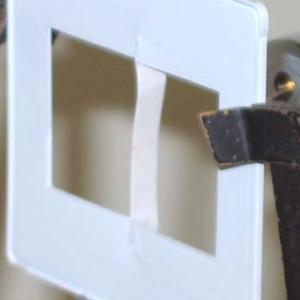College of Liberal Arts & Sciences
6D10.10 - Interference - Laser and Cornell Plate (Db. Slit)
The slit plate has single, double, and multiple as well as variable slits on it. With the laser as shown you can show a variety of diffraction and interference patterns. Information on the plate is in the file.
Two variations of the laser and slit plate demo are as follows. To easily see what the difference between a single and double slit diffraction pattern look like, shine the laser through the double slit pattern. Then with a razor blade cover one of the slits. In this way you can instantly see the difference between the two patterns.
Direct a diffuse laser beam onto the central diffraction pattern. Using the 7 cm. lens you can focus two different images. At the focal length you get a row of diffracted dots as if the laser beam was not expanded. Outside the focal length you get an image of the diffraction pattern that is on the slit plate.
By using the pointer or the variable slit to block one or more of the diffraction nodes out of the transmitted image, the image will at times become more focused and at other times less focused depending on which nodes are blocked.
A simple reproduction of Thomas Young's original experiment is to place a 2 mm piece of note card edgewise into the beam of a laser pointer. Use the variable focus laser pointer and adjust it to the narrowest beam possible. You will get a double slit pattern on the screen that can be investigated in a variety of ways.
- Chun-Ming Chiang, Shih-Hsin Ma, Shou-Tai Lin, Wel-Hung Hsu, Pin-Jui Huang, "Application of Optical Path Drawing Technology: The Light Intensity Problem of Double-Slit Interference", TPT, Vol. 60, #6, Sept. 2022, p. 457.
- Alan DeWeerd, "Inexpensive Single and Double Slits Using a Fine-Toothed Comb", TPT, Vol. 60, #5, May 2022, p. 380.
- J. P. Sharpe, C. Yee, "Young's Two-Slit Experiment Without a Laser", TPT, Vol. 59, #6, Sept. 2021, p. 420.
- Chang-won Kang, Hyen-Jung Nam, Jung Bog Kim, "Pseudo-Double-Slit Experiment with Two Glass Plates", TPT, Vol. 58, #9, Dec. 2020, p. 649.
- Chun-Ming Chiang, Shih-Hsin Ma, Jyun-Yi Wu, and Yao-Chen Hung, "3-D Optical Path Drawing Method", TPT, Vol. 57, #3, Mar. 2019, p. 179.
- Tom Ekkens, "Two-Dimensional Light Diffraction From an EPROM Chip", TPT, Vol. 56, #2, Feb 2018, p. 70.
- Robert D. Polak, Nicolette Fudala, Jason T. Rothchild, Sam E. Weiss, and Marcin Zelek, "Easily Accessible Experiments Demonstrating Interference", TPT, Vol. 54, #2, Feb. 2016, p. 120.
- Athanasios Velentzas, "Teaching Diffraction of Light and Electrons: Classroom Analogies to Classic Experiments", TPT, Vol. 52, #8, Nov. 2014, p. 493.
- Dave Van Domelen, "Binder Clip Optics Bench for Young's Double-Slit Experiment", TPT, Vol. 50, #2, Feb. 2012, p. 116.
- Paul Hewitt, "Figuring Physics: Double Slit", TPT, Vol. 48, #5, May 2010, p. 284.
- Jim Hicks, "Laser Beams, Plastic Cassette Boxes, and the Joy of Serendipitous Discovery", TPT, Vol. 47, #3, Mar. 2009, p. 189.
- Ronald Newburgh, "Optical Path, Phase, and Interference", TPT, Vol. 43, #8, Nov. 2005, p. 496.
- Michael I. Sobel, "Correction: 'Algebraic Treatment of Two-Slit Interference' [Phys. Teach. 40 (7), 402–404 (2002)]", TPT, Vol. 41, #2, Feb. 2003, p. 69.
- Dick C. H. Poon, "How Good Is the Approximation 'Path Difference ≈ d sin θ'?", TPT, Vol. 40, #8, Nov. 2002, p. 460.
- Andrew DePino Jr., "Diffraction Patterns Using a Constant-Velocity Cart", TPT, Vol. 40, #7, Oct. 2002, p. 418.
- Michael I. Sobel, "Algebraic Treatment of Two-Slit Interference", TPT, Vol. 40, #7, Oct. 2002, p. 402.
- Rand S. Worland and Matthew J. Moelter, "Hands-On Phasors and Multiple-Slit Interference", TPT, Vol. 35, #8, Nov. 1997, p. 486.
- Kenneth Ford, "Double-Slit Experiment on Web", TPT, Vol. 35, #8, Nov. 1997, p. 474.
- Thomas B. Greenslade, Jr., "Quick Measurement of Wavelength of Laser Light", TPT, Vol. 35, #5, May 1997, p. 309.
- William Moebs and Jeff Sanny, "A Simple Description of Coherence", TPT, Vol. 32, #1, Jan. 1994, p. 54.
- Walter Scheider, "Bringing One of the Great Moments of Science to the Classroom", TPT, Vol. 24, #4, Apr. 1986, p. 217.
- Y. P. Hwu and Jeffrey C. Repass, "Young's Experiment Gratings Made Holographically", TPT, Vol. 19, #4, Apr. 1981, p. 249.
- H. L. Armstrong, "Demonstrating Interference", TPT, Vol. 17, #4, Apr. 1979, p. 255, also A Potpourri of Physics Teaching Ideas - Optics and Waves, p. 235.
- Changsug Lee, Kwangmoon Shin, Sungmuk Lee, and Jaebong Lee, "Fabrication of Slits for Young's Experiment Using Graphic Arts Films", AJP, Vol. 78, #1, Jan. 2010, p. 71.
- P. F. Hinrichsen, "A Simple Interference Scanner", AJP, Vol. 69, #8, Aug. 2001, p. 917.
- Ralph Baierlein and Vacek Miglus, "Illustrating Double-Slit Interference: Yet Another Way", AJP, Vol. 59, #9, Sept. 1991, p. 857.
- R. D. Bahuguna, Arthur B. Western, and Sean Lee, "Young's Double-Slit Experiment Using Speckle Photography", AJP, Vol. 56, #6, June 1988, p. 531.
- W. Klein, "The Direct Display of Diffraction Patterns Using an Electric Razor", AJP, Vol. 54, #10, Oct. 1986, p. 956.
- A. F. Leung, "Laser Wave-Front Measurement With a Double Slit: A Classroom Demonstration", AJP, Vol. 53, #11, Nov. 1985, p. 1115.
- D. D. Long and L. C. Bolling, "Three-Dimensional Interference-Diffraction Patterns", AJP, Vol. 51, #4, Apr. 1983, p. 380.
- P. B. Pipes, T. F. Dutton, "Simple Recording Photometer for Diffraction Experiments", AJP, Vol. 44, #4, April 1976, p. 399.
- Nobuo Naba, "A Method to Vary Continuously the Slit Spacing on the Diffraction Experiments by a Laser", AJP, Vol. 40, #2, Feb. 1972, p. 341.
- Virgil B. Eligns, "A Simple Method to Vary Continuously the Effective Slitwidth and Slit Spacing on Single- and Multiple- Slit Diffraction Gratings", AJP, Vol. 38, #10, Oct. 1970, p. 1263.
- E. Fortin, "Direct Demonstration of the Fresnel-Arago Law", AJP, Vol. 38, #7, July 1970, p. 917.
- Freier and Anderson, "Ol-9", A Demonstration Handbook for Physics.
- "O-405: Double Slit with Laser", DICK and RAE Physics Demo Notebook.
- T. Kallard, "Young's Double Slit Method for Producing Interference", Exploring Laser Light, p. 112.
- T. Kallard, "Interference and Interferometers", Exploring Laser Light, p. 111.
- Borislaw Bilash II and David Maiullo, "Wave Theory of Light", A Demo a Day: A Year of Physics Demonstrations, p. 348.
- Julien Clinton Sprott, "6.2, Laser Beam", Physics Demonstrations, ISBN 0-299-21580-6, p. 235.
- Gordon McComb, "Experiments with Double Slits", Lasers, Ray Guns, & Light Cannons, p. 121 - 123.
- Seville Chapman and Harold Meese, "Effective and Inexpensive Slits for Teaching Physical Optics", Cornell Aeronautical Laboratory, Inc., Buffalo, New York, August 8, 1956.
- C. Harvey Palmer, "Experiment B19: Demonstration of Missing Orders", Optics - Experiments and Demonstrations, John Hopkins Press, 1962.
- C. Harvey Palmer, "Experiment B1: Young's Interference", Optics - Experiments and Demonstrations, John Hopkins Press, 1962.
- "22, Young's Experiment on Interference", Experiments in Optics, Part 1, J. Klinger Scientific Apparatus Corp., Bulletin 101.
- T. D. Rossing, C. J. Chiaverina, "5.2, Light Passing Through Two Slits: Young's Experiment", Light Science, Physics and Visual Arts, p. 106.
- T. D. Rossing and C. J. Chiaverina, "#3, Two-Slit Interference", Light Science, Physics and Visual Arts, p. 125.
- Robert P. Crease, "Light A Wave: Young's Lucid Analogy", The Prism & The Pendulum, Ch. 5, p. 104 - 117.
- "Double Slit Interference", Selective Experiments in Physics, CENCO, 1962.
- W. Bolton, "Young's Experiment", Book 2 - Waves and Particles, Physics Experiments and Projects, 1968, p. 22.
Disclaimer: These demonstrations are provided only for illustrative use by persons affiliated with The University of Iowa and only under the direction of a trained instructor or physicist. The University of Iowa is not responsible for demonstrations performed by those using their own equipment or who choose to use this reference material for their own purpose. The demonstrations included here are within the public domain and can be found in materials contained in libraries, bookstores, and through electronic sources. Performing all or any portion of any of these demonstrations, with or without revisions not depicted here entails inherent risks. These risks include, without limitation, bodily injury (and possibly death), including risks to health that may be temporary or permanent and that may exacerbate a pre-existing medical condition; and property loss or damage. Anyone performing any part of these demonstrations, even with revisions, knowingly and voluntarily assumes all risks associated with them.



